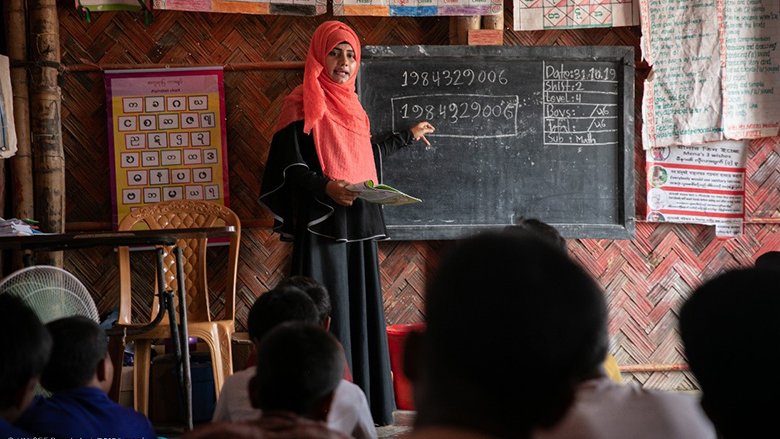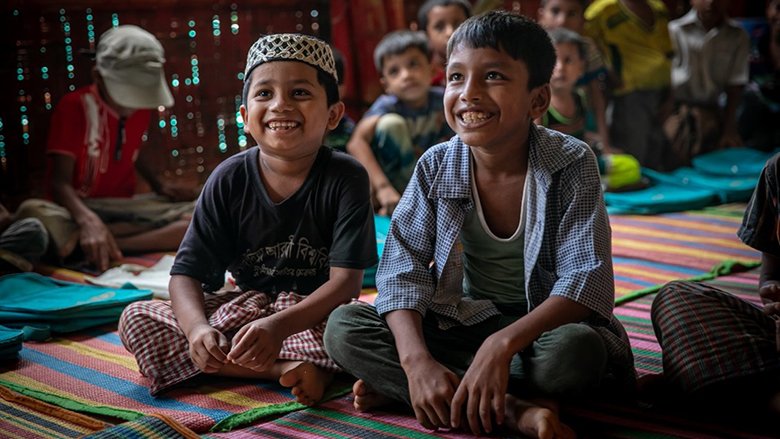Challenge
By the mid-2010s, although enrollment and gender parity rates improved at both primary and secondary levels, Bangladesh still faced a persistently high adult functional illiteracy rate at over 50 percent and low education completion rates. Around five million children aged six to 13 remained out of school mostly in under-served areas and urban slums. In addition, from 2017, following an ethnic conflict in Myanmar, about a million displaced Rohingya people moved to camps in Bangladesh’s southeastern Cox’s Bazar district, more than 350,000 of them children requiring urgent educational and psychosocial support. The influx created further pressure on the already stretched local economy and social services, resulting in a further increase in school dropout rates and disengaged youth, especially girls and young women, in the hosting community.
Approach
Bangladesh’s goal of universal primary enrolment is hindered by persistent inequity of access, completion rates, learning outcomes, and transition to upper grades and to secondary education. ROSC II, which began implementation in 2013, provided children at high risk of dropout with programs built on experience from both public schools and NGO-based innovations that blend formal and non-formal education. ROSC II created new opportunities for children in targeted deprived communities to complete Grade 5 and pursue secondary education. Since 2017, ROSC II has facilitated the creation of innovative learning centers (LCs) providing non-formal education through Government-NGO-UN collaboration and financial support from the IDA 19 Sub-Window for Refugees and Host Communities. Throughout the project, the Government has created robust monitoring and certification systems that have helped to scale and sustain such public-NGO-UN and community partnerships.
According to the ROCS II Theory of Change, the number of out-of-school children, especially girls and the disadvantaged, who have access to education would be increased by (i) providing grants to establish LCs (including in urban slums) and conditional allowances given to students who attend; (ii) enhancing education quality and grade retention through teacher development and classroom support; and (iii) strengthening management, monitoring and evaluation, learning assessments, and certification. In the long-term, this would lead to improved completion rates and improved life opportunities, allowing people to lead productive lives and escape poverty.
Results
The principal results have been:
- Access to Primary Education: ROSCII provided access to second-chance education to 687,556 out of school children, about 49% of whom were female, in 148 sub-districts in around 20,000 community-managed LCs. About 87% of the supported children were categorized as disadvantaged. Nearly 48,000 urban slum children received primary education following the accelerated learning model (2013 to 2019).
- Support for Rohingya children: About 112,000 Rohingya children were enrolled in 1,331 LCs inside the camps. Around 300,000 children received psychosocial support (2017-2021).
- Quality of Education: A total of 18,000 rural LC teachers received training and refreshers (2013-2018). Some 3,000 teachers in Cox’s Bazar received training through a UNICEF module in Cox’s Bazar for ensuring quality education in the LCs inside the camps (2019-2020). The average grade retention rate was improved to as high as 83% and the pass rate in the completion exam was 84%.
Bank Group Contribution
Original financing (Board Approval in October 2012) was US$130 million IDA Credit. An Additional Financing (AF) of US$25.0 million was added from the IDA-18 Regional Sub-Window for Refugees for providing educational support to the Rohingya children (September 2018). A second AF of US$6.5 million was added to cover exchange rate losses (December 2020).
The United States Agency for International Development (USAID) provided a US$2.5 million trust fund (Bank Executed) to support the design of the ROSC II pilots and evidence-based impact evaluations. The Government of Canada co-financed US$4.1 million for Rohingya Children’s education by buying down the credit portion of the grant from the IDA Refugee Window.
Partners
The Project’s success depended on the cooperation of several NGOs, United Nations Agencies and Development Partners. LCs in rural areas were established with the support of over 70 local NGOs who helped establish community committees and manage the LCs, and provided training to teachers and SMC members. Save the Children, an international NGO, worked as a specialized agency to help design and implement the Urban Slum and Vocational Training components. UNICEF was responsible for the implementation of the Rohingya education component through eight partner NGOs. The Institute of Education and Research of Dhaka University designed and monitored the training programs. USAID and Canada co-financed the design and activities.
Moving Forward
ROSC II established a successful system for reaching vulnerable, out-of-school children. The program’s sustainability was the subject of continuous attention during its implementation and remains a high priority for the Government’s goal of universal basic education set forth in its National Education Policy. To ensure the mainstreaming of the program’s approach, the activities of ROSC II, including the innovative approach, are being replicated by the Government’s Primary Education Development Program 4 (PEDP4), which is co-financed by an SDR 484.2 million (US$700 million equivalent) IDA Credit and by resources provided by nine other Development Partners.
Beneficiaries
Nahid Sarker, 15, lives with his parents in a village in North-Western Bangladesh (Natore District). In 2014, Nahid enrolled in an Ananda School supported by ROSC II. After completing five years’ education Nahid participated in the PEC Examination in 2018, constantly struggling against adversities and achieving a 4.08 GPA, a first step toward his dream of becoming a pilot. The ROSC II project provided free books, a school bag, a uniform, and a stipend. He is now in grade VII, continuing his studies at Kuripakia Fazil Madrasha in the Nahore district. “My dream is to educate myself, escape poverty and put a smile on my parents’ faces,” he said.

